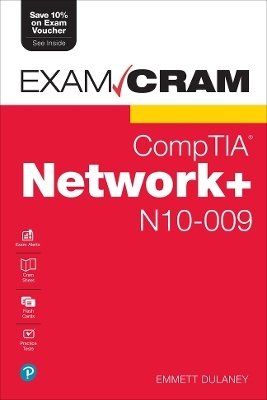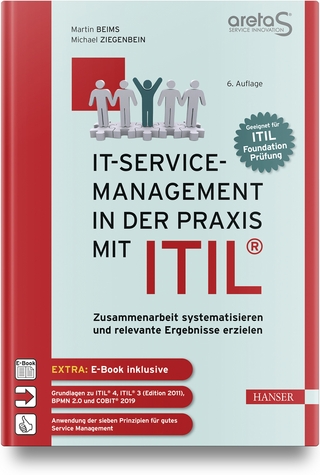
CompTIA Network+ N10-009 Exam Cram
Pearson IT Certification (Verlag)
978-0-13-534083-7 (ISBN)
Covers the critical information needed to score higher on your Network+ N10-009 exam!
Establish network connectivity by deploying wired and wireless devices
Learn the purpose of documentation and maintain network documentation
Configure common network services
Learn basic datacenter, cloud, and virtual networking concepts
Monitor network activity and troubleshoot performance and availability issues
Implement network security hardening techniques
Manage, configure, and troubleshoot network infrastructure
Prepare for your exam with Pearson Test Prep
Realistic practice questions and answers
Comprehensive reporting and feedback
Customized testing in study, practice exam, or flash card modes
Complete coverage of CompTIA Network+ N10-009 exam objectives
Emmett Dulaney (CompTIA Network+, Cloud+, Security+, A+, and others) has been the author of several books on certifications and operating systems over the past 25 years. He is a columnist for Certification Magazine and a professor at a small university in Indiana. He is currently the editor of a journal devoted to business education (and the business of education).
Introduction
CHAPTER 1 Networking Models, Ports, Protocols, and Services
The OSI Networking Model
The OSI Seven-Layer Model
Comparing OSI to the Four-Layer TCP/IP Model
Identifying the OSI Layers at Which Various Network Components Operate
Data Encapsulation/Decapsulation and OSI
Ports, Protocols, Services, and Traffic Types
Connection-Oriented Protocols Versus Connectionless Protocols
Internet Protocol
Transmission Control Protocol
User Datagram Protocol
Internet Control Message Protocol
IPsec
Generic Routing Encapsulation
File Transfer Protocol (FTP)
Secure File Transfer Protocol (SFTP)
Secure Shell (SSH)
Telnet
Simple Mail Transfer Protocol (SMTP)
Domain Name System (DNS)
Dynamic Host Configuration Protocol (DHCP)
Trivial File Transfer Protocol (TFTP)
Hypertext Transfer Protocol (HTTP)
Network Time Protocol (NTP)
Simple Network Management Protocol (SNMP)
Lightweight Directory Access Protocol (LDAP)
Hypertext Transfer Protocol Secure (HTTPS)
Server Message Block (SMB)
Syslog
Simple Mail Transfer Protocol Secure (SMTPS)
Lightweight Directory Access Protocol over SSL (LDAPS)
Structured Query Language (SQL) Server
Remote Desktop Protocol (RDP)
Session Initiation Protocol (SIP)
Understanding Port Functions
Traffic Types
What’s Next?
CHAPTER 2 Network Topologies, Architectures, and Types
Network Topologies
Star/Hub and Spoke
Mesh Topology
Hybrid Topology
Point to Point
Spine and Leaf
Three-Tier Hierarchical Model
Collapsed Core
Traffic Flows
Older Topologies: Bus and Ring
What’s Next?
CHAPTER 3 Network Addressing, Routing, and Switching
IPv4 Network Addressing
An Overview of IPv4
IP Address Classes
Subnet Mask Assignment
Subnetting
Identifying the Differences Between IPv4 Public and Private Networks
Classless Interdomain Routing
Default Gateways
Assigning IP Addresses
Identifying MAC Addresses
Routing and Switching Technologies
The Default Gateway
Routing Tables
Static Routing
Default Route
Switching Methods
Dynamic Routing
Route Selection
Address Translation
First Hop Redundancy Protocol (FHRP)
Virtual IP
Subinterfaces
Virtual Local-Area Networks
Interface Configuration and Switch Management
Voice VLAN
Trunking
The Spanning Tree Protocol (STP)
Maximum Transmission Unit (MTU)
Network Services
Dynamic Host Configuration Protocol
The DHCP Process
DHCP and DNS Suffixes
DHCP Relays and IP Helpers
Domain Name Service (DNS)
The DNS Namespace
Types of DNS Entries
DNS Records
DNS in a Practical Implementation
Time Protocols
What’s Next?
CHAPTER 4 Network Implementations
Common Networking Devices
Router
Switch
Firewall
IDS/IPS
Load Balancer
Proxy Server
Network-Attached Storage (NAS)
Storage-Area Networks
Wireless Access Point
Wireless LAN Controller
Applications/Content Delivery Network
VPNs
Quality of Service
Time To Live (TTL)
Networking Use Cases
Software-Defined Networking
Virtual Extensible Local-Area Network (VXLAN)
Zero Trust Architecture (ZTA)
Secure Access Secure Edge (SASE)/Security Service Edge (SSE)
Infrastructure as Code (IaC)
IPv6 Addressing
Comparing IPv4 and IPv6 Addressing
What’s Next?
CHAPTER 5 Cabling Solutions and Issues
General Media Considerations
Broadband Versus Baseband Transmissions
Simplex, Half-Duplex, and Full-Duplex Modes
Data Transmission Rates
Wired Versus Wireless
Types of Wired Network Media
Types of Media Connectors
Media Couplers/Converters
TIA/EIA 568A and 568B Wiring Standards
Straight-Through Versus Crossover Cables
Rollover and Loopback Cables
Ethernet Copper and Fiber Standards
Multiplexing Options
Troubleshooting Common Cable Connectivity Issues
Limitations, Considerations, and Issues
Throughput, Speed, and Distance
Cabling Specifications/Limitations
Cabling Considerations
Cabling Issues
Signal Degradation
Interference
Improper Termination
Incorrect Pinout
Bad Ports
Open/Short
LED Status Indicators
Duplexing Issues
TX/RX Reversed
Dirty Optical Cables
Interface Issues
Hardware Issues
Power over Ethernet Issues
Transceiver Issues
Common Tools
Cable Crimpers, Strippers, and Snips/Cutters
Punchdown Tools
Tone Generator
Loopback Adapter
TDR/OTDR
Multimeter
Cable Tester
Wire Map
Tap
Fusion Splicer
Spectrum Analyzer
Fiber Light Meter
What’s Next?
CHAPTER 6 Wireless Solutions
Understanding Wireless Basics
Wireless Channels and Frequencies
Speed, Distance, and Bandwidth
Channel Bonding
MIMO/MU-MIMO/Directional/Omnidirectional
Network Types
Establishing Communications Between Wireless Devices
Guest Networks
Configuring the Wireless Connection
Autonomous and Lightweight Access Points
What’s Next?
CHAPTER 7 Cloud Computing Concepts and Options
Cloud Concepts
Service Models
Software as a Service
Platform as a Service
Infrastructure as a Service
Deployment Models
Private Cloud
Public Cloud
Hybrid Cloud
Multitenancy
Elasticity
Scalability
Network Functions Virtualization (NFV)
Cloud Connectivity Options
Virtual Private Cloud (VPC)
Cloud Gateways
Network Security, Groups, and Lists
What’s Next?
CHAPTER 8 Network Operations
Physical Installation Factors
Components of Wiring Distribution
Using Uninterruptible Power Supplies
Beyond the UPS
Environmental Factors
Organizational Processes and Procedures
Wiring and Port Locations
Physical and Logical Network Diagrams
Baseline/Golden Configurations
Policies, Procedures, Configurations, and Regulations
Labeling
Monitoring Network Performance
Common Performance Metrics
SNMP
Network Performance, Load, and Stress Testing
Network Device Logs
Disaster Recovery and High Availability
Backups
Backup Best Practices
Cold, Warm, Hot, and Cloud Sites
High-Availability Approaches and Recovery Concepts
Active-Active Versus Active-Passive
DR Testing
Network Access and Management Methods
Site-to-Site VPN
Client-to-Site VPN
Connection Methods
Jump Box
In-Band Versus Out-of-Band Management
What’s Next?
CHAPTER 9 Network Security
Common Security Concepts
Encryption
Access Control
Mandatory Access Control
Discretionary Access Control
Rule-Based Access Control
Role-Based Access Control
Defense in Depth
Separation of Duties
Deception Technologies: Honeypots and Honeynets
RADIUS and TACACS+
Kerberos Authentication
Local Authentication
Lightweight Directory Access Protocol
Using Certificates
Identity and Access Management (IAM)
Security Assertion Markup Language (SAML)
Multifactor Authentication Factors
Auditing and Regulatory Compliance
Additional Access Control Methods
Risk Management
Penetration Testing
Security Information and Event Management
Common Networking Attacks
Denial-of-Service and Distributed Denial-of-Service Attacks
Other Common Attacks
Vulnerabilities and Prevention
Applying Network Security
Disposing of Assets
Secured Versus Unsecured Protocols
Key Management
Hardening Best Practices
Wireless Security
Working with Zones
What’s Next?
CHAPTER 10 Network Troubleshooting
Troubleshooting Steps and Procedures
Identify the Problem
Establish a Theory of Probable Cause
Test the Theory to Determine the Cause
Establish a Plan of Action
Implement the Solution or Escalate
Verify Full System Functionality
Document Findings, Actions, Outcomes, and Lessons Learned Throughout the Process
Troubleshooting Common Networking Issues
Common Considerations
Common Problems to Be Aware Of
Hardware Failure
Network Performance Issues
Wireless Issues
Site Surveys
Factors Affecting Wireless Signals
Troubleshooting AP Coverage
Troubleshooting Tools
Toner
Cable Tester
Taps
Visual Fault Locator
Wi-Fi Analyzer
Protocol Analyzer
Speed Tester
Port Scanner
LLDP and CDP
NetFlow Analyzer
TFTP Server
Terminal Emulator
IP Scanner
Command-Line Tools
The Trace Route Utility (tracert/traceroute)
ping
ARP
The netstat Command
ipconfig
ifconfig
nslookup
dig
The tcpdump Command
The route Utility
nmap
Basic Networking Device Commands
What’s Next?
Cram Sheet
Online
Glossary
9780135340837 TOC 7/25/2024
| Erscheinungsdatum | 21.08.2024 |
|---|---|
| Reihe/Serie | Exam Cram |
| Verlagsort | Upper Saddle River |
| Sprache | englisch |
| Maße | 154 x 228 mm |
| Gewicht | 824 g |
| Themenwelt | Informatik ► Weitere Themen ► Zertifizierung |
| ISBN-10 | 0-13-534083-7 / 0135340837 |
| ISBN-13 | 978-0-13-534083-7 / 9780135340837 |
| Zustand | Neuware |
| Informationen gemäß Produktsicherheitsverordnung (GPSR) | |
| Haben Sie eine Frage zum Produkt? |
aus dem Bereich


